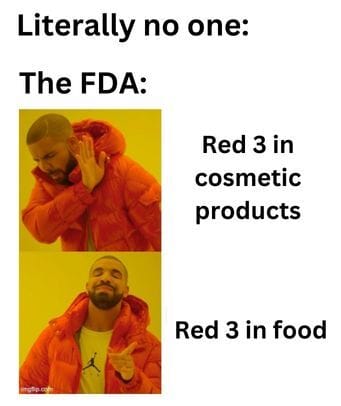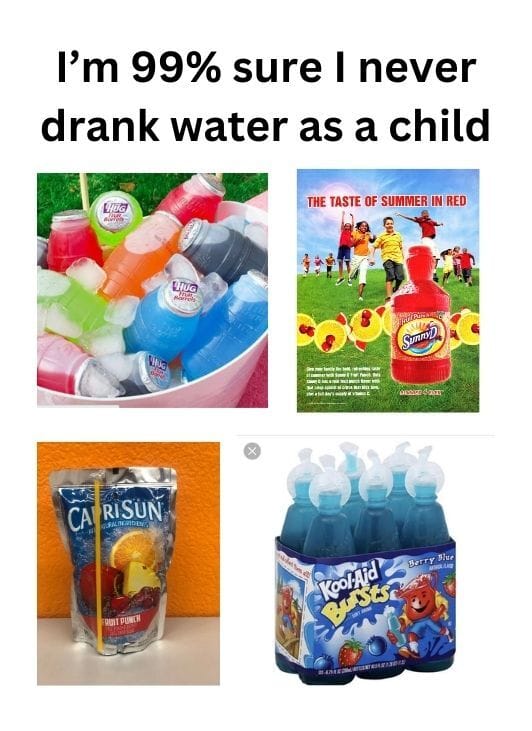
GM! This is PoopMates HQ bringing you another fresh edition of the PoopMates newsletter.
If you’re snacking on something bright red, yellow, or electric blue right now… you might want to check the label. Today, we’re diving into the truth about synthetic food dyes and how they could be messing with you in more ways than you think. Let’s get into it

🚨 Red Alert: The FDA Banned One Toxic Dye… But What About the Rest? 🚨
The FDA finally pulled the plug on a toxic food dye—so why are we still swimming in artificial colors?
🔴 Red No. 3 has officially gotten the boot. After years of research linking it to cancer and gut disruption, the FDA has decided that maybe—just maybe—we shouldn’t be sprinkling carcinogens into our food. 🤯 Shocking, right? But before you celebrate with a victory lap around your pantry, there’s a bigger problem:
🚨 This ban is just the tip of the ICEE-berg.
Because while Red 3 is out, a whole lineup of equally questionable synthetic dyes—like Red 40, Yellow 5, and Blue 1—are still in nearly every processed food aisle. Worse? Many of these are already banned or restricted in other countries, while Americans keep consuming them like it's the 1950s and smoking on airplanes is still a thing.
Let’s talk about why this matters and what these dyes are doing to your gut.
WTF Took So Long??
Red 3, also known as erythrosine, has been under scrutiny for decades. Back in 1990, the FDA banned it from cosmetics after research linked it to thyroid tumors in rats. But for some reason, food manufacturers got a free pass.
💀 Cancer risk? ✅
💩 Gut disruption? ✅
→ Still approved for food coloring? ✅ (until now)

The final nail in the coffin came from persistent research and public pressure, leading the FDA to finally revoke its approval for foods and drugs. But here’s the kicker—companies have until 2027 to phase it out, so you’ll still be seeing it in candy, snacks, and processed foods for the next few years.
Food Dyes and Your Gut: A Bad Trip for Your Microbiome
Beyond the big C risk, artificial dyes are bad news for your gut. And if you care about your microbiome (which you should), here’s why:
🔥 Inflammation City: Research shows that Red 40—a cousin of the newly banned Red 3—can disrupt gut bacteria and trigger inflammation, which can worsen conditions like IBS and Crohn’s.
🧬 Microbiome Mayhem: A study from the University of Guelph found that common food dyes alter gut microbial communities, potentially leading to digestive imbalances and metabolic issues.
🧠 Dopamine Disruptors? Emerging research suggests some artificial dyes may mess with neurotransmitters, impacting mood, focus, and behavior. Europe even requires warning labels on products with these dyes because of potential effects on children’s attention. If you want to read more about the gut-dopamine connection, check out a previous post here.
Wait… If Red 3 is Banned, What About the Others?
Here’s the real problem: many artificial dyes remain perfectly legal in the U.S., even though they’re banned elsewhere.
🚫 Red 40 (banned in Denmark, Belgium, France, and Switzerland)
🚫 Yellow 5 & 6 (require warning labels in the EU)
🚫 Blue 1 & 2 (restricted in multiple countries)
And guess what? They’re everywhere.
🥤 Soda & Sports Drinks
🍭 Candy
🥣 Breakfast Cereals
🧁 Packaged Cakes & Frosting
🧀 Chips & crackers
What Can You Do?
🔎 Read labels—Look for sneaky ingredients like “FD&C Red 40” and “Artificial Color.”
🥕 Go for natural colors—Beet juice, turmeric, and spirulina are actually good for you.
🚫 Ditch the ultra-processed junk—Color dyes aren’t the only reason you should avoid processed foods. Just avoid them entirely, your gut will thank you.
The FDA’s Red 3 ban is a step in the right direction, but it’s not enough. If other countries have already kicked these dyes out, why are we still stuck with them?
It may seem obvious, but here’s what we’d like to see:

💄 Bonus: If You Shouldn’t Eat It, You Shouldn’t Rub It On Your Body Either
Think food dyes are just a snack-time problem? Think again. Like we mentioned earlier with the ban on Red 3 in beauty products, these synthetic colors don’t just show up in your favorite artificially bright foods—they’re also hiding in cosmetics, skincare, and personal care products. And just like with food, your body absorbs what you put on it.
🧐 Where They’re Hiding:
Lipsticks & Lip Glosses 💋 - Red 40, Yellow 5—yep, the same ones in your candy
Blush & Eyeshadows 🎨 - Synthetic dyes for that “natural” flush
Shampoos & Conditioners 🚿 - You’re hair color is beautiful just the way it is!
Toothpaste & Mouthwash 🦷 - Ever wonder why kid’s toothpaste is electric blue?
If your gut wouldn’t approve of it in your food, maybe your skin doesn’t want it either. Just a thought. 🤷♂️

🚨 The Bottom Line
The FDA finally axed Red 3, but the food industry is still drowning in artificial dyes—many of which are banned elsewhere. Your best defense? Read labels, ditch the artificially colored junk, and opt for natural alternatives whenever you can. Your gut, brain, and overall health will thank you. 💩✨

💩 SH!TTY MEMEZ 🤣



(Don’t be this guy)

If you haven’t already, check out the PoopMates mobile app on the iOS app store! We are constantly pushing updates so be sure to keep an eye for new features too.
Also, be sure to follow our twitter/x for more memes and gut-health related content!
That’s all for today, folks. We hope you enjoyed it. Now go, fertilize the Earth! The planet needs you.
DISCLAIMER: The content provided in this newsletter is for informational purposes only and is not intended as a substitute for professional medical advice, diagnosis, or treatment. If you are experiencing a medical emergency, call your doctor or dial 911 immediately.

